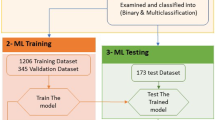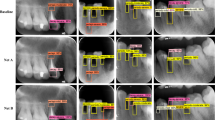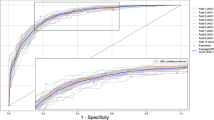Abstract
Objectives
We aim to develop a deep learning model based on a convolutional neural network (CNN) combined with a classification algorithm (CA) to assist dentists in quickly and accurately diagnosing the stage of periodontitis.
Materials and methods
Periapical radiographs (PERs) and clinical data were collected. The CNNs including Alexnet, VGG16, and ResNet18 were trained on PER to establish the PER-CNN models for no periodontal bone loss (PBL) and PBL. The CAs including random forest (RF), support vector machine (SVM), naive Bayes (NB), logistic regression (LR), and k-nearest neighbor (KNN) were added to the PER-CNN model for control, stage I, stage II and stage III/IV periodontitis. Heat map was produced using a gradient-weighted class activation map** method to visualize the regions of interest of the PER-Alexnet model. Clustering analysis was performed based on the ten PER-CNN scores and the clinical characteristics.
Results
The accuracy of the PER-Alexnet and PER-VGG16 models with the higher performance was 0.872 and 0.853, respectively. The accuracy of the PER-Alexnet + RF model with the highest performance for control, stage I, stage II and stage III/IV was 0.968, 0.960, 0.835 and 0.842, respectively. Heat map showed that the regions of interest predicted by the model were periodontitis bone lesions. We found that age and smoking were significantly related to periodontitis based on the PER-Alexnet scores.
Conclusion
The PER-Alexnet + RF model has reached high performance for whole-case periodontal diagnosis. The CNN models combined with CA can assist dentists in quickly and accurately diagnosing the stage of periodontitis.








Similar content being viewed by others
Data availability
The data that support the findings of this study are available on request from the corresponding author. The data are not publicly available due to privacy or ethical restrictions.
References
Papapanou PN, Mariano S, Nurcan B, et al. Periodontitis: consensus report of workgroup 2 of the 2017 world workshop on the classification of periodontal and peri-implant diseases and conditions. J Periodontol. 2018;89:S173–82.
Tan L, Liu J, Liu Z. Association between periodontitis and the prevalence and prognosis of prediabetes: a population-based study. J Transl Med. 2023;21(1):484.
Siow DSF, Goh EXJ, Ong MMA, et al. Risk factors for tooth loss and progression of periodontitis in patients undergoing periodontal maintenance therapy. J Clin Periodontol. 2022;50(1):61–70.
Luthra S, Orlandi M, Hussain SB, et al. Treatment of periodontitis and C-reactive protein: a systematic review and meta-analysis of randomized clinical trials. J Clin Periodontol. 2022;50(1):45–60.
Li A, Qiu B, Goettsch M, et al. Association between the quality of plant-based diets and periodontitis in the US general population. J Clin Periodontol. 2023;50(5):591–603.
Frencken JE, Sharma P, Stenhouse L, et al. Global epidemiology of dental caries and severe periodontitis-a comprehensive review. J Clin Periodontol. 2017;44(Suppl 18):S94–105.
Gedik R, Marakoglu I, De Mirer S. Assessment of alveolar bone levels from bitewing, periapical and panoramic radiographs in periodontitis patients. West Indian Med J. 2008;57(4):410–3.
Huynh JD, Rhodes SC, Hatton JF, et al. Satisfaction of search in periapical radiograph interpretation. J Endod. 2021;47(2):291–6.
Hermanson BP, Burgdorf GC, Hatton JF, et al. Visual fixation and scan patterns of dentists viewing dental periapical radiographs: an eye tracking pilot study. J Endod. 2019;44(5):722–7.
Vandenberghe B, Jacobs R, Bosmans H. Modern dental imaging: a review of the current technology and clinical applications in dental practice. Eur Radiol. 2010;20(11):2637–55.
Musri N, Christie B, Ichwan S, et al. Deep learning convolutional neural network algorithms for the early detection and diagnosis of dental caries on periapical radiographs: a systematic review. Imaging Sci Dent. 2021;51(3):237–42.
Zhu X, Cheng Z, Wang S, et al. Coronary angiography image segmentation based on PSPNet. Comput Methods Programs Biomed. 2020;200(4): 105897.
Liu D, Jia Z, ** M, et al. Cardiac magnetic resonance image segmentation based on convolutional neural network. Comput Methods Programs Biomed. 2020;197(45): 105755.
Chang P, Dang J, Dai J, et al. Real-time respiratory tumor motion prediction based on a temporal convolutional neural network: prediction model development study. J Med Internet Res. 2021;23(8): e27235.
Bayrakdar IS, Orhan K, Akarsu S, et al. Deep-learning approach for caries detection and segmentation on dental bitewing radiographs. Oral Radiol. 2022;38:468–79.
Ver Berne J, Saadi SB, Politis C, et al. A deep learning approach for radiological detection and classification of radicular cysts and periapical granulomas. J Dent. 2023;135: 104581.
Watanabe H, Ariji Y, Fukuda M, et al. Deep learning object detection of maxillary cyst-like lesions on panoramic radiographs: preliminary study. Oral Radiol. 2021;37:487–93.
Liu Y, Fan R, Yi J, et al. A fusion framework of deep learning and machine learning for predicting sgRNA cleavage efficiency. Comput Biol Med. 2023;165: 107476.
Chang J, Chang MF, Angelov N, et al. Application of deep machine learning for the radiographic diagnosis of periodontitis. Clin Oral Invest. 2022;26(11):6629–37.
Lee CT, Kabir T, Nelson J, et al. Use of the deep learning approach to measure alveolar bone level. J Clin Periodontol. 2022;49(3):260–9.
Caton JG, Armitage G, Berglundh T, Chapple ILC, et al. A new classification scheme for periodontal and peri-implant diseases and conditions - Introduction and key changes from the 1999 classification. J Clin Periodontol. 2018;89(Suppl 1):S1–8.
Krizhevsky A, Sutskever I, Hinton G. ImageNet classification with deep convolutional neural networks. Adv Neural Inf Proc Syst. 2012;25(2):84–90.
Simonyan K, Zisserman A. Very deep convolutional networks for large-scale image recognition. Computer Science. 2014. ar**v: 1409.1556.
Ou X, Yan P, Zhang Y, et al. Moving object detection method via ResNet-18 with encoder-decoder structure in complex scenes. IEEE Access. 2019. https://doi.org/10.1109/ACCESS.2019.2931922.
Tian L, Wu W, Yu T. Graph random forest: a graph embedded algorithm for identifying highly connected important features. Biomolecules. 2023;13(7):1153.
Noble WS. What is a support vector machine? Nat Biotechnol. 2006;24(12):1565–7.
Yu L, Gan S, Chen Y, et al. A novel hybrid approach: instance weighted hidden Naive Bayes. Mathematics (Basel). 2021;9(22):2982.
Cornish RP, Bartlett JW, Macleod J, et al. Complete case logistic regression with a dichotomised continuous outcome led to biased estimates. J Clin Epidemiol. 2022;154:33–41.
Zhang Q, Sheng J, Zhang Q, et al. Enhanced Harris hawks optimization-based fuzzy k-nearest neighbor algorithm for diagnosis of Alzheimer’s disease. Comput Biol Med. 2023;165: 107392.
Selvaraju RR, Cogswell M, Das A, et al. Grad-CAM: visual explanations from deep networks via gradient-based localization. Int J Comput Vision. 2020;128(2):336–59.
Lakhani P, Sundaram B. Deep learning at chest radiography: automated classification of pulmonary tuberculosis by using convolutional neural networks. Radiology. 2017;284(2):574–82.
Chang J, Meng HW, Lalla E, et al. The impact of smoking on non-surgical periodontal therapy: a systematic review and meta-analysis. J Clin Periodontol. 2021;48(1):60–75.
Gulshan V, Peng L, Coram M, et al. Development and validation of a deep learning algorithm for detection of diabetic retinopathy in retinal fundus photographs. JAMA–J Am Med Assoc. 2016;316(22):2402–10.
Acknowledgements
The authors gratefully acknowledge the financial support of the Key Research General Project of Department of Science and Technology of Jiangxi Province (20212BBG73006); the Cross-funding Project of Nanchang University (9166-27060003-ZD04); the Clinical Research Project of the Second Affiliated Hospital of Nanchang University (2021efyA04); and the Research Foundation of the Education Department of Jiangxi Province (GJJ14085). The authors declare no potential conflicts of interest with respect to the authorship and/or publication of this article.
Funding
This article is funded by Nanchang University, 9166-27060003-ZD04, Li Song, 2021efyA04, Li Song, Education Department of Jiangxi Province, GJJ14085, Fang Dai, and Natural Science Foundation of Jiangxi Province, 20212BBG73006, Li Song.
Author information
Authors and Affiliations
Contributions
FD: study concepts and design; literature research; statistical analysis; manuscript preparation. QL: study concepts and design; statistical analysis; manuscript preparation. YG, RX, JW, TD, HZ: experimental studies/data analysis. LS: guarantor of integrity of the entire study; statistical analysis; experimental studies/data analysis; funding acquisition; manuscript editing. LD: guarantor of integrity of the entire study; statistical analysis; manuscript editing. All the authors gave final approval and agreed to be accountable for all aspects of the work.
Corresponding authors
Ethics declarations
Conflict of interest
The authors declare that they have no conflict of interest.
Ethical approval
All the procedures were performed in accordance with the ethical standards of the Ethics Committee of the Second Affiliated Hospital of Nanchang University and with the Helsinki Declaration of 1975, as revised in 2008 (5).
Informed consent
Informed consent was obtained from all the patients for being included in the study.
Additional information
Publisher's Note
Springer Nature remains neutral with regard to jurisdictional claims in published maps and institutional affiliations.
Supplementary Information
Below is the link to the electronic supplementary material.
Rights and permissions
Springer Nature or its licensor (e.g. a society or other partner) holds exclusive rights to this article under a publishing agreement with the author(s) or other rightsholder(s); author self-archiving of the accepted manuscript version of this article is solely governed by the terms of such publishing agreement and applicable law.
About this article
Cite this article
Dai, F., Liu, Q., Guo, Y. et al. Convolutional neural networks combined with classification algorithms for the diagnosis of periodontitis. Oral Radiol 40, 357–366 (2024). https://doi.org/10.1007/s11282-024-00739-5
Received:
Accepted:
Published:
Issue Date:
DOI: https://doi.org/10.1007/s11282-024-00739-5




